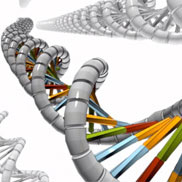« Prev Next »

Introduction: What Is DNA?

However, DNA does more than specify the structure and function of living things — it also serves as the primary unit of heredity in organisms of all types. In other words, whenever organisms reproduce, a portion of their DNA is passed along to their offspring. This transmission of all or part of an organism's DNA helps ensure a certain level of continuity from one generation to the next, while still allowing for slight changes that contribute to the diversity of life.
But what, exactly, is DNA? What smaller elements make up this complex molecule, how are these elements arranged, and how is information extracted from them? This unit answers each of these questions, and it also provides a basic overview of the process of DNA discovery.
Further Exploration
Key Questions
eBooks
This page appears in the following eBook





















